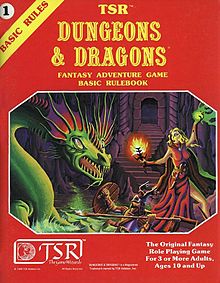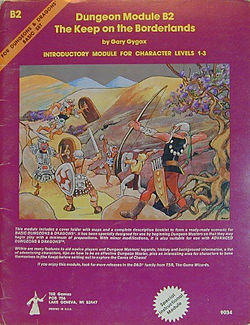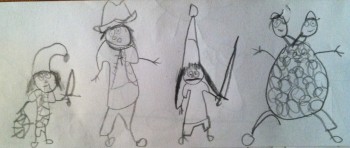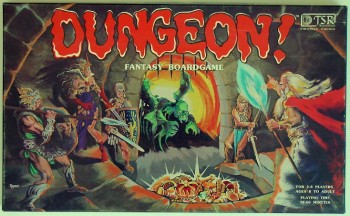Modular: Oz’s Bag of Holding: Breaking Out Basic D&D for the Next Generation
 I have here a bag of holding. I am going to pull some things out of it now…
I have here a bag of holding. I am going to pull some things out of it now…
Well, I’ve gone and done it. I’ve broken open the floodgates and moved my children on from Dungeon! The Board Game to the real deal.
This is fortuitous timing, as M Harold Page has launched a new series of posts (READ HERE) on Black Gate about introducing kids to tabletop role playing (which I have been reading with newly-relevant interest).
My daughter and son will soon be turning 8 and 6 respectively. Bringing the son in on things might have been a bit premature — he’s more apt to grab the miniatures and fight with them like action figures than to sit and patiently listen to a Dungeon Master try to paint a scenario in his mind’s eye.
To introduce these acolytes, I dug out my 1981 D&D Basic set (1981 edition). After decades of d20, revisiting this chestnut three decades later is kinda hilarious. D20 is so elegantly simple in concept: Hit a monster with AC 18? Roll a d20, add modifiers, and get an 18 or better. But with old-school D&D, no! You look at the monster’s AC and then have to consult a chart (I confess I’d forgotten what THAC0 even stood for). Cross-reference monster’s AC with character’s level to see what you have to roll. Basic? No, not really. Pretty damn cumbersome!
Anyway, my son created a fighter named “Cool Dude,” who apparently has two heads (although I’m generally ignoring that in game play – except I did add in a special skill that his character can never be snuck up on). My wife, getting into the spirit of role-playing, refers to one of his heads as “Cool” and the other as “Dude.”
My daughter chose an Elf (because she made clear at the outset “I want a ranger with a spirit animal”). Since neither rangers nor familiars exist in Basic, she went with Elf and I ported in an animal companion for her (a black panther that she named Ranger).
Say, what’s this with races equaling classes? That’s weird. If you’re a human, you can be a Thief or a Fighter or a Magic User or a Cleric, but if you’re an elf, your profession is Elf. Halflings inevitably pursue the career of halflinging. Dwarves choose the highly specialized life path of being a Dwarf.
Come on — what about the dwarven clerics that must certainly exist? Or halfling thieves? Halflings seem naturally suited to the skills of Thieves, but only Thieves can do Thief things, which means only humans can detect traps or sneak around or move silently etc. Also reeks of speciesism, and I’m sure they got a lot of flak from the National Assocation for the Advancement of Halflings (NAAH).
 And back to Elves. Elves as a class are so powerful, the rule-makers thought — combining both Fighter and Magic-User — that they had to be limited in other ways for game balance. (Yeah, every single elf in Basic-Land happens to be both a fighter and spell-book-carrying magic user, because that matches no known elf in prior literature, myth, or legend). Non-human races/classes have a level cap: Elves can’t progress beyond 10th level! But don’t worry — they need twice as many experience points per level as a Fighter to progress, so you’ll likely never get there anyway.
And back to Elves. Elves as a class are so powerful, the rule-makers thought — combining both Fighter and Magic-User — that they had to be limited in other ways for game balance. (Yeah, every single elf in Basic-Land happens to be both a fighter and spell-book-carrying magic user, because that matches no known elf in prior literature, myth, or legend). Non-human races/classes have a level cap: Elves can’t progress beyond 10th level! But don’t worry — they need twice as many experience points per level as a Fighter to progress, so you’ll likely never get there anyway.
So what we’re saying is that by the time my son’s two-headed fighter Cool Dude hits 4th level, poor Pointy will still be 2nd level with fewer hit points per level (d6 vs. d8) — just because a couple times a day she can also cast a spell to Detect Magic? Whoop-dee-frickin’-doo. And thus are House Rules born.
My wife is an elf named Oona. Frankly, I can tell my wife wants to polish off Ceara, her 13th-level druid, but it’s going to be a while before we get back to 3.5e.
I’m playing an NPC, a 3rd-level cleric named Bale (because I have a feeling this party is going to need a lot of healing).
Update
We’ve been plundering the Caves of Chaos (Keep on the Borderlands: Dungeon Module B2 by Gary Gygax), with a few DM-generated side episodes along the way (e.g., my son was jealous that my daughter had a “spirit animal,” so I arranged for him to adopt a black bear). Cool Dude is now 4th level and Pointy is 3rd (she should still be 2nd but House Rules).
My wife made another House Rule for the DM at the very outset: the kids’ characters CANNOT die; it would be too traumatic for their sensitive young minds. So I have been introducing a few NPCs along the way – “redshirts” who do not end up faring so well…
Also, just in case, I have an elderly gentleman lurking in the background, regarding the party’s progress with interest. My good ol’ sorcerer Ropespor, hanging around with a Reincarnation spell. Just in case.
My wife also has to remind me audience every now and then when it comes to graphic description. For instance, “When your son rolls a crit hit on the kobold with his +1 broadsword, you don’t need to provide the detail that the little lizard-dog is cleaved right in two through his abdomen, his upper torso toppling through the air and splatting against the cave wall.”
To Be Continued…
D&D, even keeping it simple, is a lot for kids this age. They like to play it sometimes, but not as often as I do. So on a recent family game night my daughter suggested, “Let’s take a break from D&D.”
Me: “Okay, what would you like to play instead tonight?”
Daughter: “Dungeon!!”


The weird attack rolls that predate the d20 system and the elf and dwarf character classes are the two main reasons I never really looked at Basic in 14 years of running and playing RPGs. Which turned out to be a real shame.
Converting the big attack tables and negative AC to the sane d20 method is trivial and you can just use the four standard classes for characters of every race. (Who cares about seeing in the dark and sometimes detecting secret doors.) Just play a cleric like any other cleric and declare it’s a dwarf. Or a whatever else you can think of.
Once past these two minor hurdles, Basic/Expert is a fantastic game. I would even say the best fantasy RPG that is out there. It has a simplicity and elegance (aside from those needlessly funky attack rolls) that has still not been surpassed in 36 years.
10 years back when the old D&D games from the 80s came back into fashion (with a certain crowd) AD&D was all the rage at first. But now pretty much everyone who publishes new material for oldschool D&D is using Basic. It’s so much simpler and just gives you the most basic framework of rules to let you do with it whatever you can think of, without gettin bogged down in bookkeeping minutiae.
@Martin Kallies, Yeah, revisiting the original, I can see how everything essential for tabletop role-playing is already there.
I can appreciate how later editions and iterations progressed with the pure motives of wanting to fix things like the aforementioned rules limitations, but then Rules Bloat inevitably sets in. Pretty soon you’ve got a system where characters need a Skill category for Sewing and have to roll d20 to see if they successfully sew a button back on…
Hey, Nick. Not long ago, Brett and Sean talked about Race as Class in RPGs over at their GamingandBS podcast.
https://gamingandbs.com/race-class-rpgs-gbs119/
Yeah, it seems kind of weird for us d20 folks, but I’m okay with it, even moreover prefer it after the rules bloat to which you refer. Again I recommend Swords and Wizardry to D&D Basic. Matt Finch has ironed through a lot of the weirdisms and created a very entertaining read.
I too am thinking of writing about kids and rpgs, because of my experience trying it mostly unsuccessfully with my first three, because I’m hoping to be successful with my latest, because I might have an alternative view to the one purported by Page — and this last is because I experienced some of what you talked about — that kids often have difficulty getting right into D&D. I can see Page’s assertion that anything else is not the “thing,” that kids want to do what the grown ups do, but I also think there are perfectly awesome games, playable by adults as well, that might ramp up to the D&D experience. Many of these I recently got inexpensively through a Bundle of Holding drive.
As you might know, I am so royally scorched by the Skill systems from the d20 rules. I can’t remember who said this — maybe Byrne? — that a lot of the d20 rules might have originated as a way to protect players from GMs (as strange as this seems). My Pathfinder campaign collapsed at level 11, mostly because one player in particular had succeeded in “winning” the game through rules exploitation. I couldn’t threaten this character in any way without derailing the system, and the character also unjustly therefore enjoyed the limelight in gross misproportion to the other players. The next time I run a traditional fRPG I’m definitely eschewing a Skill system. I’m leaning towards Swords and Wizardry or Tunnels and Trolls.
I’m all for checking out Tunnels and Trolls! Like you, I’ve always been curious about that game. Still being published, by the original author: I think it’s in its 4th edition
@Gabe Dybing: Hey, aren’t those tricked-out, nigh invincible characters called “munchkins” in RPG slang?
Could you have done this?: Consult the Deities & Demigods, posit that a pantheon of gods had noticed this upstart mortal and decreed that he was growing too powerful and decided to intervene…
On the idea of demigods intervening with my upstart mortal, yes, I certainly could have. The short of it is that this person and myself didn’t play well together, and I’m never running a game with him again. But more than that (and maybe some others want to weigh in here), Pathfinder recommends a Challenge Rating (CR) for average party level. On average, any physical conflict should not exceed CR+3 (epic level encounter). This guy routinely dealt with CR+3 and more on HIS OWN, which not only frustrates me but also was unfair to his players.
It was a very interesting experience. People counseled me to try talking to him (I did try), playing to his weaknesses (which again becomes very much GM vs player and unfair to the other players, because it again puts this character into the limelight — and I just wanted to tell a story — different play styles, to say the least), or outright ask him to leave the game (I did, and he somehow promised his way back into it; another time he quit, and then wouldn’t leave the table in the very public hobby shop). Anyway, let’s just say it’s been my first experience with irreconcilable differences. Others might say I’ve been trolled. I will say that it not only caused a rupture between me and this player and — by unhappy extension — the other players at the table, but between me and Pathfinder as a game system. I am so soured on it. And I know firsthand what many mean when they talk about a game being “broken.”
Yep, this has been my one and only experience with a munchkin, a min/max’er, a power gamer.
Actually, Tunnels and Trolls is in at least its 8th edition.
The newest version is called Tunnels and Trolls Deluxe. That comes in a big hardback book.
You also could go for the edition before that and get Tunnels and Trolls 7.5.
I’ve read through the 7.5 edition many times, but i’ve never played it with a group. They won’t switch from DnD.
I have tried several of the solitaire scenarios, which are really just choose your own adventure with T&T rules.
Hi, Glenn. I’m currently reading dT&T and loving it! I think when I pause my current Yggdrasill campaign, I’ll run for my group concurrent T&T and Swords and Wizardry intro adventures and quiz them on what they prefer for a longer game.
To bad that “solo play” is mere game book play. I had suspected